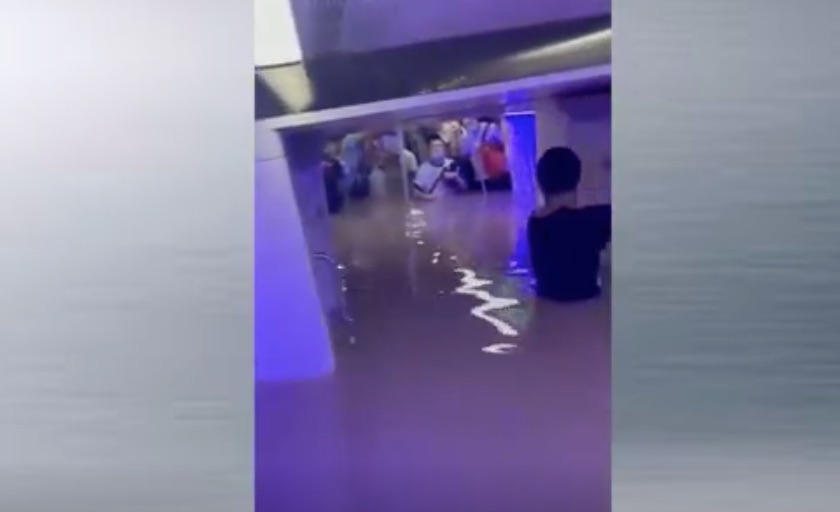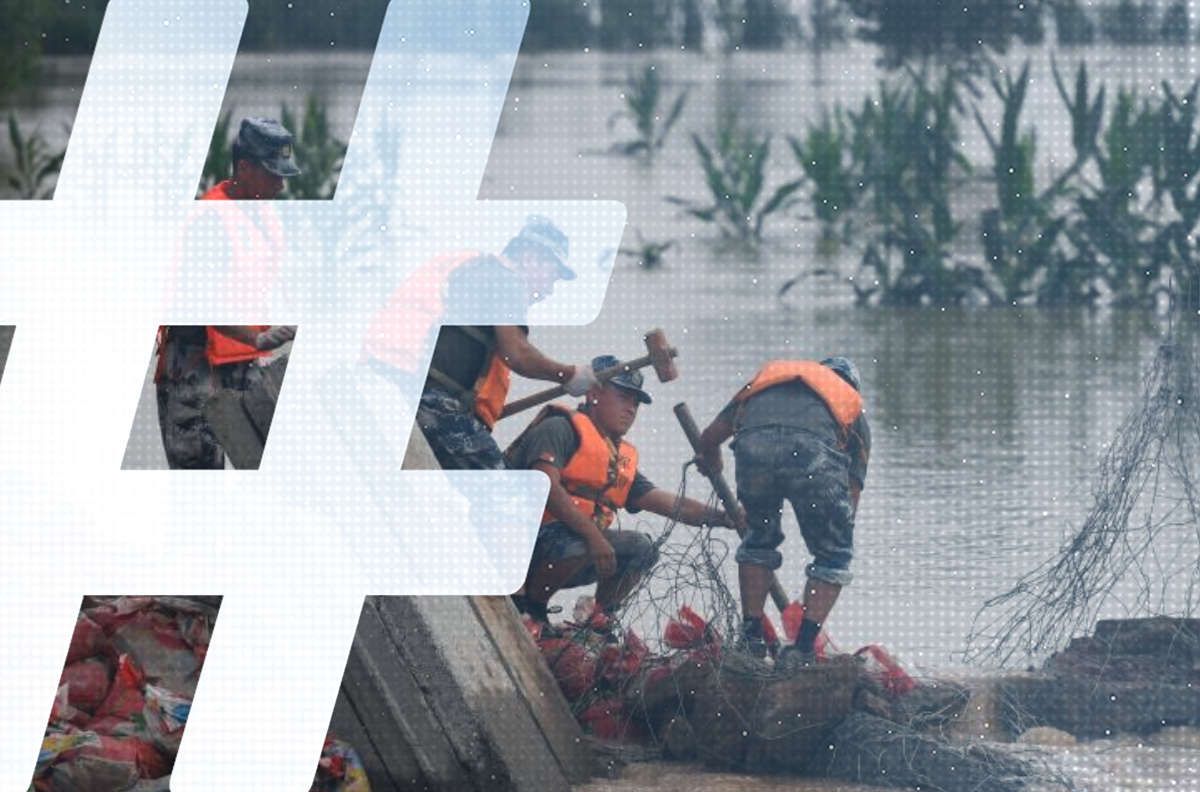Headlines and Hashtags
Trapped

The following is CMP’s translation of an eyewitness account recorded by Freezing Point intern Lu Siwei (卢思薇), and edited by Chen Zhuo (陈卓), of one passenger’s experiences on the night of July 20 as she was trapped inside a subway car on Zhengzhou’s Metro Line 5 — as the tunnels surged with rising floodwaters.
The eyewitness account was shared by Freezing Point yesterday through its WeChat public account. Freezing Point is a supplement of the China Youth Daily newspaper, published by the Chinese Communist Youth League. Launched in January 1995, the supplement became known in the years that followed more its in-depth coverage of social and political issues through essays and long-form writing. Reorganized in January 2006 after several of its pieces fell afoul of censors in the Central Propaganda Department, Freezing Point has trudged along ever since, though without the influence it once had under editors Li Datong (李大同)and Lu Yuegang (卢跃刚).
_____________
The Account of a Person Trapped Inside a Subway Car on Zhengzhou’s Line 5: Water Outside the Car is Above Human Height, and Oxygen Inside the Car is Lacking
China Youth Daily / Freezing Point
Many people had no idea that the rains would fall so relentlessly. Beginning on July 17, Zhengzhou experienced rainfall such as has rarely been seen. The data shows that the single-day rainfall in Zhengzhou surpassed historical extremes (since the establishment of monitoring stations), and single-hour rainfall exceeded the daily historical extremes. The amount of rainfall in Zhengzhou over the past three days has approached average total rainfall during normal years.
Vehicles were overturned by water on the roads and the first floors of many buildings were backed up by flood water. Trains were stopped, public transportation blocked, and many people were prevented from getting home.
On July 20, the Wulongkou Parking Lot for Zhengzhou Metro Line 5 and the area surrounding it became serious flooded. At around 6PM the same day the water flowed over a retaining wall and entered the main line section, causing trains in the Metro Line 5 tunnels at Haitansi Street Station and Shakou Road Station to stop running. Flood waters backed up into the underground tunnels and inside Line 5 trains, and passengers were trapped inside the cars. During this time, news and videos continually emerged from inside the Line 5 trains, as water in the cars rose to the chests and even heads of the passengers.
Rescuers arrived at the scene quickly after being notified by the public. By 3:10 AM on July 21, all the people trapped in the subway tunnel had been brought to safety. According to official figures, more than 500 people were evacuated in the incident, 12 people died after rescue attempts were futile, and 5 people were sent to the hospital with injuries. The following is an account as dictated by one of those trapped [inside the trains].

In the afternoon of July 20, I took the train from Central Business District Station on the Zhengzhou Metro Line 5 to head home. Probably because of the rainy weather, there weren’t too many people at the station. The subway did not run smoothly, and starting from the Huanghe Road Station there were emergency stops and other issues. Passengers still boarded along the way, so I didn’t think there was any serious problem.
The accident happened between Haitansi Street Station and Shakou Road Station. In fact, as the train arrived at Haitansi Street Station, an emergency stop was already made. But afterward the train continued ahead. At the time, I thought we would quickly reach Shakou Road Station. But before long that train had stopped once again.
Looking out from the carriage, you could already see the water rushing upward on both sides. At the time the conductor walked from the front of the train all the way to the back, and he maintained constant contact with [personnel] above ground. The conductor also tried to take the train back to Haitansi Street Station. But by that time, probably because the subway had automatic safety procedures in place, the train was locked on top of the tracks and there was no way to move. At that time, we could see sparks flashing on the tracks.
Gradually, water started pouring into the carriages. At first, most of the people in the car were gathered at the rear, but because the subway traveled from east to west, and the terrain in the west was higher than in the east, the water rose more quickly toward the back of the train, so at the conductor’s instruction everyone kept moving toward the front part of the train. As we reached the head of the train, the conductor opened the door of the car in the very front.
It was then that I learned that the subway has an internal pedestrian passage. Heeding the conductor’s command, everyone grabbed the railing and continued walking along the subway track. At that time, we must have been very close to the Shakou Road Station, and I felt that it might be just over two hundred meters away. A small group of people at the front had reached a relatively safe position, but the water coming from behind was very rapid and violent, and the pedestrian passage under the subway was extremely narrow and crowded, so not everyone could get through, and most people were forced to go back to the carriage halfway through the attempt. The conductor closed the door again and kept contact with ground personnel, awaiting rescue [crews].
During the time we were trapped in the subway, at least in my section of the car, the overall situation was still OK. Perhaps because I’m not so courageous, I had already begun to cry as I saw water entering from the rear of the train — not making a sound, just tears running down my face. Some others around me were crying or extremely anxious, and others in the same carriage would come over and comfort us. There was one girl in the carriage who kept everyone orderly and calmed us down. Everyone seemed to have agreed not to say anything demoralizing. In the end, most people chose just to stay silent in order to keep up their strength.
Everyone was trying hard to make contact with the outside world in various ways — dialing 119 or 110, contacting family and friends for assistance . . . . but the results were not very heartening. Probably everyone [around the city] was busy contacting rescue crews, and the phone network was maxed, so it was difficult for family members and friends outside to reach one another.
Fortunately, one woman inside the train was later able to reach rescue crews outside. Once she made contact, she continued letting everyone inside the carriage know the situation with the rescue crews outside. For example, that rescue crews had arrived at the exit, that they were setting up a rope for rescue, that they were placing sandbags, and so on.
The most terrible time was around 9PM that evening, as the water outside the window reached the height of a person, and looking back you could see that water at the back half of the train had already reached the top. Everyone moved forward and gathered in the first three cars, and at the time I was in the space between cars 1 and 2, right in the middle of the group. Water continued to rise, and the second half of the group were in basically up to their necks, and toward the front the water reached our chests. It was at this time that hypoxic conditions began. One by one, people all around showed signs of hypoxia, hypoglycemia, shivering, gasping for air, dry vomiting. There were children, pregnant women and the elderly in the train who began suffering a variety of physical issues, mostly due to the long hours standing in the water.
I recall that at the time that woman who was relaying rescue information to us from outside said the government had begun pumping water in the back. At the time, though, I felt that one or two pumping machines couldn’t handle such a massive amount of water. So when I heard her say that, I felt really desperate. At that time, I was truly terrified. When I saw the water level outside the cars was over our heads, I began preparing for the possibility that we wouldn’t make it out.
I hadn’t been able to dial out with my phone, but the network could still be used intermittently. Having less than 30 percent battery power at that time, I closed all of my applications to conserve power, leaving only a WeChat so that I could send messages to family and friends. I didn’t dare to talk to my parents, so I sent messages to my cousins and friends. Before 9PM, I kept asking them to contact rescuers, but seeing the water level rise over our heads, my messages to them became about end-of-life concerns.
Inside the car, I could really feel the sense of terror in the people all around me. There was also a little commotion inside the car, as at one point, when the difference in water levels [inside and outside] was most pronounced, someone tried impulsively to smash open the glass door of the car. But on older man stopped him. I feel truly grateful to that uncle. Considering the difference in water levels at the time, if he hadn’t stopped [the man], and the car windows had suddenly been smashed open, the water would have rushed in and surely would have pressed us in and made it impossible to escape.
In the back, things then took a turn for the worse. After the water level outside the carriage reached its crest, the water lines then seem to stabilize somewhat. At the same time, however, our car seemed to have shifted under the impact of the water so that one side was slightly higher than the other. On the higher side, the carriage windows were above the [rushing] body of water [outside]. It was at that time that some people suggested we use the fire extinguisher inside the car to break the windows on the higher side [to let in air] rather than try opening the doors. Once the window of the first car was smashed, the lack of oxygen situation improved significantly, and everyone gradually began resuming normal breathing. Meanwhile, the water level outside did not rise any further. Those of us toward the front of the train also communicated with those toward the back, telling them to use the fire extinguisher to break open the windows. At first there were one or two people saying it. But before long people throughout the car were saying all together, ‘Use the fire extinguisher to break the windows.”
It was also at about that time that rescue workers appeared outside the carriage. They first used the broken window to pass in a tool for breaking out the windows. Inside the cars everyone was passing the window breaker back in a line.
I was closer up toward the front, so I’m not too sure what the situation was behind me, but I remember looking back at the people in the blackness. Soon after, the rescuers managed to open the conductor’s compartment at the front of the train, and they tried to smash the windows from the outside. But as the process of chiselling at the glass was time consuming, and the car had already been opened in front, they decided not to continue. One after another, everyone was evacuated from the front carriage.
The first to be rescued were probably the two or three pregnant women, who were weak from having stood in the water for so long and from lack of oxygen. The children were rescued next, and then the women. I was among the women to be evacuated earlier on. While the water outside was then flowing more smoothly than before, it was still very fast, especially in the short distance from the carriage to the walkway. The rescuers mostly carried out their rescue efforts from the car to the handrail. As they pulled me up outside the car passengers below helped push me up. All thanks to their support in pushing and pulling me, I could escape from the current. Once I was out of the car and past the rapids, I walked about ten meters, and the water level reached a safer level just below my calves. And in the roughly 200 meters to the exit, we basically held on to each other so that we could walk, those who could walk helping those who couldn’t, following the guidance of the rescue team members up front.
As we reached the exit, we could see that many rescue workers were there trying to hold back the flood. They guided us along the rescue line they had set up so that we could trudge over. Once we exited the station we could see a lot of people walking back in our direction – rescue workers, medical staff, subway employees, and others whose profession I couldn’t guess, all heading for the subway cars. I could also see those in charge anxiously making phone calls, and employees in subway uniforms inquired about our conditions. Chairs and beds were set up along the walkway. I also saw a young mother and her child on my way out of the station. The child was fine, but the mother was obviously hypoxic and very weak, probably because she had been nursing her child.
From the beginning of the ordeal to our evacuation to safety, the whole thing lasted around four hours. After leaving the station, because the roads in the area were still in a flooded state, I was concerned about manhole covers being washed away, and also about possible electrical leaks, and so I still couldn’t go home and had to stay at a friend’s house.






















